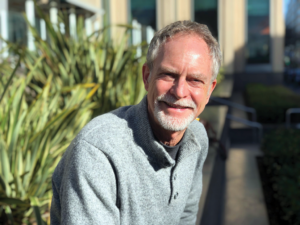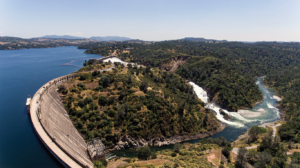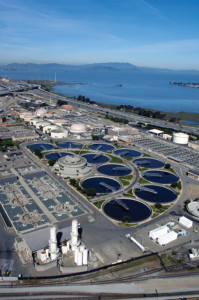T
he East Bay Municipal Utility District (East Bay MUD) has been providing drinking water to the people of California’s Bay Area for almost a century, amid rapid population growth and climatic change. Today, the threats posed by challenges such as intense storms, flooding, wildfires, and sea level rise are front and center. East Bay MUD is increasing its future resilience with a sustainability program aligned with six key goals in its strategic plan, which earned it the Association of Metropolitan Water Agencies’ Sustainable Water Utility Management Award in 2018.
In this interview, Doug Wallace, the manager of public affairs at East Bay MUD, speaks with Municipal Water Leader Managing Editor Joshua Dill about how East Bay MUD continues to provide clean water and wastewater services to the Bay Area while planning for an uncertain future.
Joshua Dill: Please tell us about your background and how you came to be in your current position.
 Doug Wallace: I have a background in both environmental sciences and public policy. I spent about 22 years as East Bay MUD’s environmental affairs officer. During that time, I was involved in a lot of advocacy
Doug Wallace: I have a background in both environmental sciences and public policy. I spent about 22 years as East Bay MUD’s environmental affairs officer. During that time, I was involved in a lot of advocacy
on statewide issues. One thing that I focused on was the CALFED Bay-Delta Program, which aimed to find consensus-based approaches to managing California’s complex statewide water system, the heart of which is in the delta at the confluence of the Sacramento and San Joaquin rivers.
At a certain point, I began to switch gears and focus on sustainability and our own management and operations. East Bay MUD is widely recognized as an industry leader in environmental stewardship, natural resources, and sustainability. We were the first water agency to actively support the greenhouse gas emissions law AB 32, which was passed in 2006 and required California to meet hard targets in reducing greenhouse gas emissions. East Bay MUD adopted similar targets to reduce its greenhouse gas emissions, and it is well ahead of the trajectory to meet those goals. Addressing climate change is a centerpiece in our sustainability efforts, which also include dealing with solid-waste management and renewable energy.
Joshua Dill: Would you give us an overview of East Bay MUD’s history and services?
Doug Wallace: We came into being as a municipal utility district under the auspices of the state law known as the MUD Act back in 1923. At the time, the East Bay was developing rapidly and was reliant on local water sources. That was simply not going to work in the long run. We acquired water rights on the Mokelumne River, which is a fairly small river fed by snowmelt from the Sierra Nevada, and built what was then the tallest dam in the country, Pardee Dam.
That dam started supplying water to the East Bay region in the late 1920s, really in the nick of time, before
local supplies started running out. In the 1950s, by a vote of the people, we extended our responsibilities
as a municipal utility by providing wastewater treatment services for an area roughly half the size of our water service area.
Our water service area is about 332 square miles in size, and covers portions of Alameda and Contra Costa Counties; the wastewater service area is roughly half that. The populations of those areas are about 1.4 million and 685,000, respectively. We are an independent, not-for-profit district with our own publicly elected, seven-member board of directors. We’re not attached to a city, a county, or the state.
We have two major reservoirs in the Sierra foothills, which straddle the county line between Amador and Calaveras Counties, and three aqueducts, each around 90 miles in length, that bring that water to the East Bay, where it’s treated in one of several treatment plants. The Mokelumne River supplies about 90 percent of our needs—slightly less during drought years, when we maximize conservation and draw in water from other sources, including the Sacramento River, via transfers.
Joshua Dill: What percentage of your service area is urbanized?
Doug Wallace: We are highly urbanized. We have several large cities in our service area, including Berkeley, Oakland, Richmond, and Walnut Creek. We have no real agriculture in our service area, aside from some private vineyards and golf courses.
One of the marvelous features of the San Francisco Bay Area is that a lot of open space has been preserved. We control 29,000 acres of carefully protected watershed, which is managed to maintain
water quality and biodiversity. That watershed surrounds five terminal reservoirs, including the Chabot and San Pablo Reservoirs, which were the main sources of water for the East Bay back in the 1920s.
We anticipate that most of the development moving forward will be urban infill. In California, there is an increasing emphasis on transit-friendly residential development as an alternative to the sprawl that has been the typical development pattern for most of the last half century.
Joshua Dill: Would you give us an overview of East Bay MUD’s sustainability efforts?
Doug Wallace: We have embraced the concept of the triple bottom line. In common parlance, a bottom line
is purely financial. However, if you’ve ever heard critiques of gross domestic product (GDP), you know that financial bottom line does not equate to quality of life. For example, an oil spill can add to GDP because of the money spent on cleanup. The notion of a triple bottom line was developed in the 1990s to embrace financial, environmental, and social factors.
Our sustainability efforts are centered around six long-term goals. The first is ensuring a long-term water supply. California as a state made tremendous gains in water conservation during the last drought, and fortunately, those seem to have been structural changes. For example, a lot of people got rid of their lawns and didn’t replace them when water supplies returned to nor mal. We are also committed to recycling and reusing wastewater in order to supply businesses and industries and for use in landscape irrigation. We are also increasingly involved in groundwater replenishment, which requires us to work with institutional partners outside our service area. California has had a banner year for snowpack and precipitation, so this will be a perfect year to bank some surface water supplies into depleted aquifers. Another way we work on firming up our long-term water supply is by detecting leaks in our large pipeline distribution system. It takes a lot of commitment and technological refinement to get pipeline loss down to even 10 percent.
mal. We are also committed to recycling and reusing wastewater in order to supply businesses and industries and for use in landscape irrigation. We are also increasingly involved in groundwater replenishment, which requires us to work with institutional partners outside our service area. California has had a banner year for snowpack and precipitation, so this will be a perfect year to bank some surface water supplies into depleted aquifers. Another way we work on firming up our long-term water supply is by detecting leaks in our large pipeline distribution system. It takes a lot of commitment and technological refinement to get pipeline loss down to even 10 percent.
Our second goal is maintaining water quality and environmental protection, which includes our commitment to reduce greenhouse gas emissions. That has been supported greatly by state policies to reduce the greenhouse gases associated with electricity production. We’re also looking at constructing two 5-megawatt photovoltaic solar power arrays. Those are quite large—they could cover 20 acres each.
Our wastewater treatment plant fundamentally exists to protect the San Francisco Bay’s water quality and aquatic habitat. The plant, at the base of the Bay Bridge, processes wastewater and trucked waste, and produces so much clean biofuel that it not only runs completely on the energy it produces, but it sells surplus energy to the grid. This is the first wastewater treatment plant in North America to produce more energy than it requires for operations. Trending issues to address in terms of bay protection include preventing microplastics and nutrients from entering the bay through the wastewater effluent stream.
Another element of our sustainability work is managing the Mokelumne River salmon fishery. The construction of dams on the Mokelumne River, particularly the construction of Camanche Dam in the 1960s for flood control purposes, blocked a significant amount of salmon spawning habitat. To remedy that, we built a salmon hatchery at the foot of Camanche Dam. It has had enormous success in replenishing the salmon run on the river. The Mokelumne River provides only 2–3 percent of the outflow of the California Delta, but due to the success of our fishery management, our hatchery fish constitute over 40 percent of the commercial catch and over 30 percent of the recreational catch of salmon off the coast of California. We also participated actively in getting 37 miles of the Mokelumne River designated by the state as a Wild and Scenic River.
We are also doing a major rehabilitation of our downtown administrative office to improve its heating, ventilation, and air-conditioning systems and to bring it up to Energy Star–rated levels for energy conservation and LED lighting.
Our third goal is long-term infrastructure investment. We continually monitor and maintain our dams and make major investments in pipeline replacement to reduce leaks. Our budget includes funds to upgrade our water treatment plants so that they can handle water of varying quality, which we might need to use because of drought or a change in our water sources. As we adapt to climate change, we will not be able to rely so completely on our Mokelumne River supply. Additionally, we are putting a lot of money into maintaining the 90 miles of aqueducts that bring water to the East Bay from the Sierras.
Workforce planning and development is our fourth sustainability goal. Our number of days lost to injury
has plummeted. We’ve made a lot of progress on that by working closely with our unions. Like other water agencies, we’re concerned about where we will get qualified employees in the future. For example, there is a shortage of capable water treatment plant and wastewater treatment plant operators. We are working with local community colleges to establish a pipeline of talent to help students qualify for highly desirable jobs at East Bay MUD. We also had one of the first customer assistance programs in the state. This fund helps subsidize water rates for people with low incomes.
Long-term financial stability is our fifth goal. Our debt-to-service ratio has improved substantially over recent years. Our current budget proposal focuses on increasing the cash funding of capital projects and relying less on debt. Obviously, an East Bay MUD debt burden is a burden for all ratepayers. We have a high bond rating, which is one measure of our financial stewardship.
The last of the six goals is customer and community services. We continue to increase the number of customers signed up for electronic bill payments. Additionally, the Bay Area is experiencing rapid economic growth, and with all the new businesses applying for water service, we’re always looking at easing the paperwork burden. We are continually upgrading our ways of engaging with the public as social media and telecommunications evolve.
Joshua Dill: You mentioned that climate change is one of the most important factors shaping your future. Would you give an overview of what effects you expect to see in your service area?
Doug Wallace: We are already experiencing the destabilization of the climate. California has the most variable climate of any of the 50 states when it comes to precipitation. There is no longer any such thing as a normal water year here. We have recently had wild swings from punishing drought to record-breaking rain and snowfall.  The most obvious effect of climate change on water providers will be drought. Drought resilience and improved water use efficiency among our customers are core elements of our long-term strategy.
The most obvious effect of climate change on water providers will be drought. Drought resilience and improved water use efficiency among our customers are core elements of our long-term strategy.
We are making big investments in our water treatment plants to handle variability in water quality. Severe storms throw a lot of sediment in the water. Wildfires are also a concern: When a source watershed is burned over, it can have serious effects on water quality. That hasn’t happened to us yet, but it is a threat.
The more immediate concern for our wastewater plant operators is intense storms that test our ability to handle inflows of wastewater. We are committed under a consent agreement with the U.S. Environmental Protection Agency to reduce and minimize the excess flows that we have to release at times, which contain partially treated wastewater. That is a pollution issue.
We’re already experiencing sea level rise, which is compounded by ground subsidence of certain kinds of bayshore soils and greatly exacerbated by king tides and storm surges. It affects us in several ways. Our wastewater treatment plant is located just above sea level and is surrounded by a lot of infrastructure, including Interstate Highway 80, the east span of the Bay Bridge, and other urban development along the East Bayshore and the Port of Oakland. All of these are vulnerable to sea level rise in the coming decades.
Sea level rise will affect us at least two more ways over the coming decades. It will lead to saline water intrusion into low-lying areas and increase the risk of the corrosion of distribution pipes, which is a problem that needs to be managed with the installation of cathodic protection.
Finally, the confluence of the Sacramento and the San Joaquin Rivers, an area of incredibly productive farmland, is crossed by our aqueducts and has subsided to below sea level. How does it still exist? The delta is surrounded by a huge network of over a thousand miles of human-made levees, all of which are subject to breach. In fact, there have been many breaches over the years that flood parts of the delta with brackish water. One of these so-called islands, which is crossed by our aqueducts, was flooded in 2006. Some of our aqueducts were even submerged for certain stretches. These above-ground aqueducts are not meant to be sitting in brackish water. For us, it is a long- term threat that the lion’s share of our water supply is conveyed by aqueducts that now are subject to flooding.
Drought, wildfire, sea level rise, and intense storm events are already happening. The San Francisco Bay Area is highly exposed. It’s a challenging time to be this business, but it’s exciting in a way. We’re fortunate to be in California, where the state has taken a global leadership role with policies that are tackling the issues of climate change and sustainability head on.
Doug Wallace is the recently retired manager of public affairs at the East Bay Municipal Utility District. For more information, please contact Clifford Chan, director of operations and maintenance, at clifford.chan@ebmud.com.
